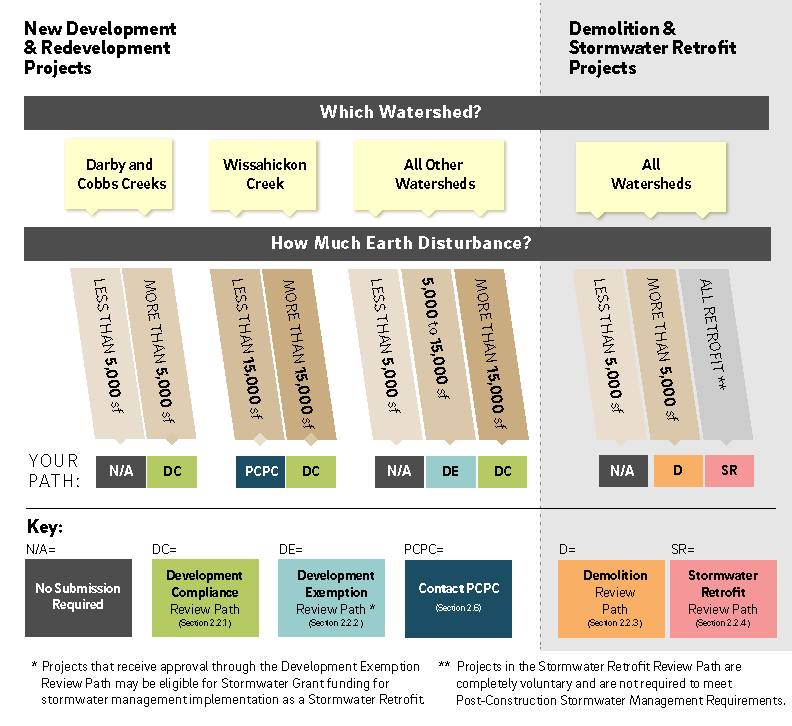Within PWD Development Services, the Stormwater Plan Review program reviews all projects in Philadelphia that generate earth disturbance of 5,000 square feet or more.
The type of review and the requirements are determined by the development category, watershed, and earth disturbance specific to each project. See Section 1.1 of the Philadelphia Stormwater Management Guidance Manual (Manual) or the planning page for more information.
There are four Review Paths: Development Compliance, Development Exemption, Demolition, and Stormwater Retrofit.

Stormwater Retrofit projects are reviewed by PWD Stormwater Billing and Incentives and this group should be contacted directly prior to making an ERSA application for more information on their review process. Projects in all other review paths should follow the procedures outlined below:
Design Process
Projects in the Demolition and Development Exemption Review Paths must submit an Erosion and Sediment (E&S) Control Plan and follow the approved E&S plan during construction. Sediment from construction projects is a major pollutant in local waters and can clog city inlets, which is why it is important to implement precautions that keep soil on-site and out of City streets, inlets, and water bodies.
A project that follows the Development Compliance Review Path must also meet the Post‑Construction Stormwater Management (PCSM) Requirements. These requirements regulate how stormwater runoff leaves a project site in its post-development condition. PCSM Requirements have four components: Water Quality, Channel Protection, Flood Control, and PHS Release Rate, which are discussed in Section 1.2.1 of the Manual.
PWD has developed an integrated design approach through which developers can meet the Stormwater Regulations for proposed development projects.
- Site assessment
- Stormwater Management Design Strategies
- Infiltration Testing and Soil Assessment for SMP Design
- How to Show Compliance
Not all SMPs are created equal. Some function better than others when it comes to overall performance, triple bottom line benefits, costs, and ease of long-term maintenance. PWD has created an SMP hierarchy to aid in selecting the best SMP for the project.
PWD has design and material standards, construction and maintenance guidance, and details for each SMP, as well as guidance for pretreatment, inlet control, and outlet control systems that support SMP functions. This information can be accessed in Chapter 4 of the Manual.
Application, Review, and Permitting Process
STEP 1: Existing Resources and Site Analysis (ERSA) Application.
STEP 2: Conceptual Review
- For projects on the Development Compliance Review Path, the Conceptual Review is a preliminary analysis of a project’s stormwater management approach and serves as PWD’s pre-requisite for the Zoning Permit. For projects on the Development Exemption and Demolition Review Paths, PWD will review the E&S plan during Conceptual Review and the Conceptual Approval letter can be used to obtain PWD’s pre-requisite for the Building or Demolition Permits.
- A response to each conceptual submission should be provided within five (5) days.
- After all comments have been addressed, a Conceptual Stormwater Management Plan Approval Fee must be received for projects on the Development Compliance Review Path prior to receiving the Conceptual Approval Letter.
STEP 3: Post Construction Stormwater Management Plan Review
- Once Conceptual Approval is obtained, projects in the Development Compliance Review Path should prepare the Post Construction Stormwater Management Plan (PCSMP) Submission.
- Submit for a Post Construction Stormwater Management Plan Review by logging into your PWD Stormwater Plan Review user account. Click on the conceptually approved project and create a new online technical worksheet. To initiate a resubmission, duplicate the most recent online technical worksheet.
Already received approval from Stormwater Plan Review? Determine what else is needed for PWD sign-off for the Building Permit application. Once you have a building permit, refer to construction guidance.
Need help?
- See Chapter 2: Submission, Review, and Approval Procedures of the Philadelphia Stormwater Guidance Manual for more information.
- Contact PWD Stormwater Plan Review at PWD.PlanReview@phila.gov
- Projects that haven’t submitted an ERSA Application can request a Pre-Application Meeting for a more formal discussion of the project with various units from PWD.
- Projects that have submitted an ERSA Application can contact their reviewer anytime with project questions.